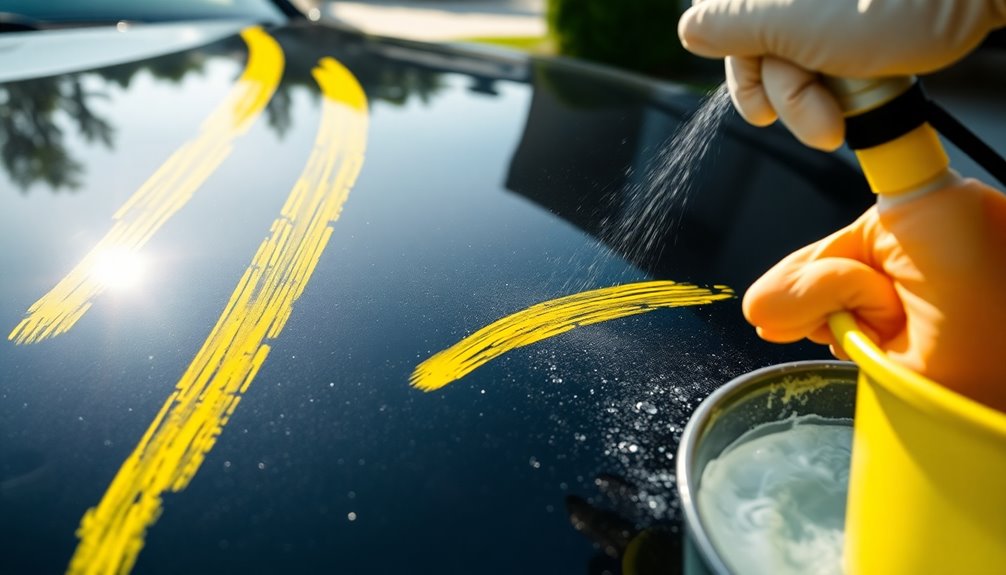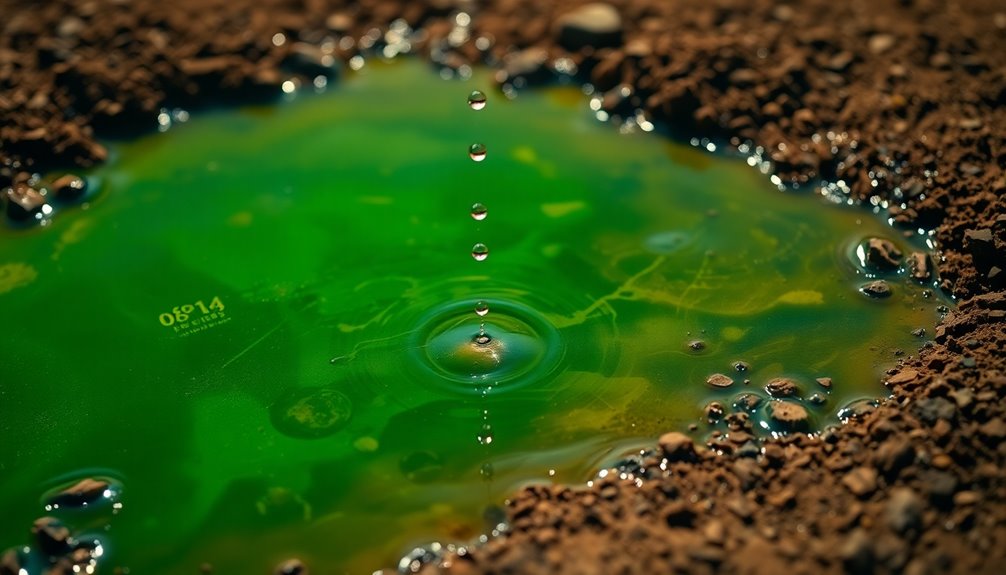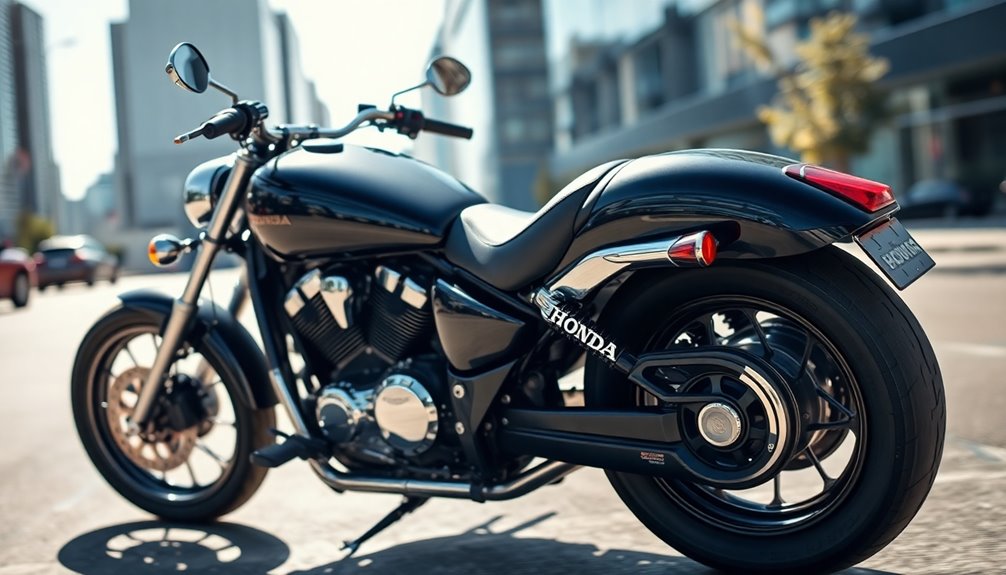To get road paint off your car, act quickly for the best results. Start by washing the area with a pressure washer to remove fresh paint. For dried paint, apply WD-40 and let it sit for 1-2 hours, then wash again. Other effective options include using petroleum jelly, mineral spirits, or specific products like Motsenbockers LIFT OFF 4. For tougher spots, try heating the paint and gently scraping with a plastic razor blade. Always wear protective gear, and consider professional help if needed. Keep going, and you'll discover even more tips for keeping your vehicle looking its best.
Key Takeaways
- Act quickly; fresh road paint can often be removed with a pressure car wash or by washing the area immediately.
- For dried paint, apply WD-40 or petroleum jelly and let it sit for 1-12 hours before washing.
- Use specialized products like Motsenbockers LIFT OFF 4 or Stoner XENIT for effective and safe paint removal.
- Heat can soften road paint; use a blow dryer or heat gun on low while scraping with plastic razor blades.
- Always test solvents on hidden areas first to avoid damaging your car's finish; wear protective gear during removal.
Understanding Road Paint Stains
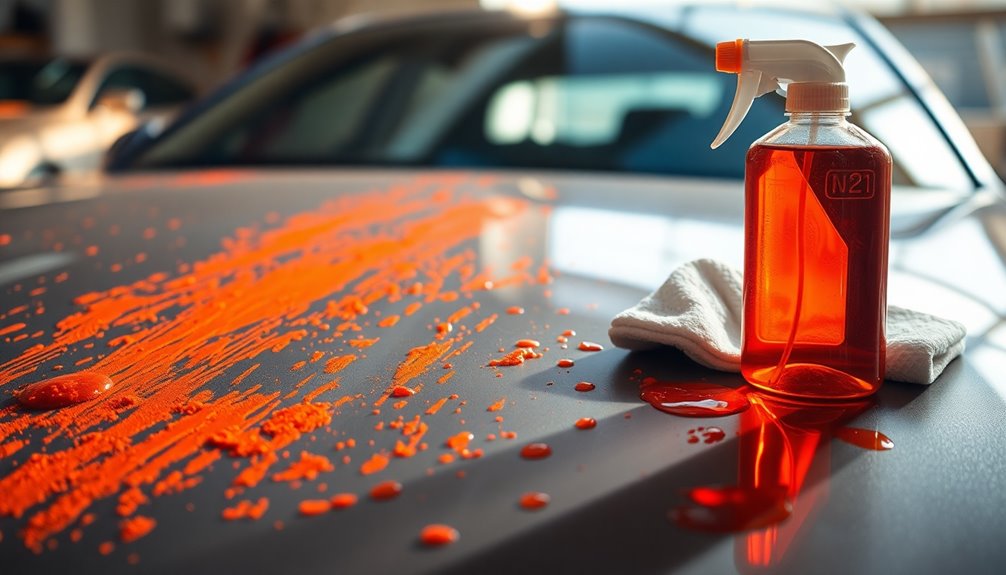
When you encounter road paint stains on your car, it's important to understand the nature of these marks. Road paint is specifically formulated to stick strongly to surfaces, making it challenging to remove without the right techniques and materials.
The Department of Transportation often uses environmentally friendly waterborne paint and durable thermoplastic polymers, both of which are designed to resist wear and tear.
Freshly applied road paint is usually easier to remove than dried paint, so acting quickly is essential. If you let the stains sit, they can greatly affect your car's aesthetic appeal and even its resale value.
Different removal methods exist, including solvents like acetone and lacquer thinner, but be cautious. Before diving in, always test any solvent on a hidden area of your vehicle to avoid damaging the finish.
Understanding the properties of road paint and the urgency of acting swiftly can save you time and effort. By addressing these stains promptly, you'll preserve your car's appearance and maintain its value.
Initial Removal Steps
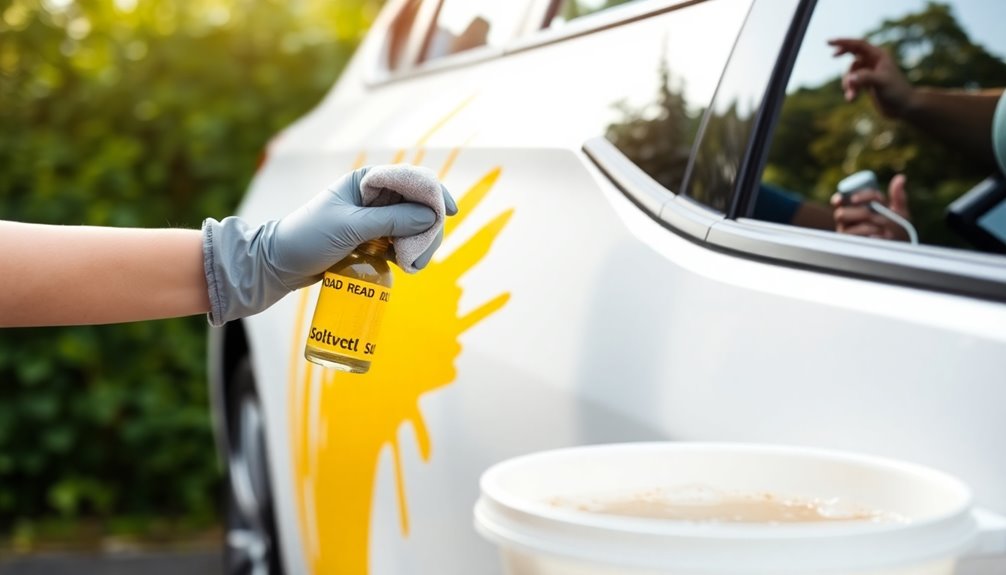
To tackle road paint stains effectively, start by washing the affected area with a pressure car wash if the paint hasn't dried for more than a day.
Using a pressure washer can help blast away fresh paint, making it easier to remove road paint before it sets in. If this initial wash doesn't completely clear the paint, you can try applying WD-40 directly to the spots.
Let it sit for 1-2 hours, then wash it off again. For heavy paint concentrations, you might need to repeat this step.
In cases where the paint has dried, petroleum jelly (Vaseline) can be your best friend.
Spread it over the stains and leave it to work its magic for 8-12 hours. Afterward, use a pressure washer to remove the softened paint.
Alternatively, consider mineral spirits or a product like Stoner XENIT Citrus Cleaner. Apply it with a damp microfiber towel and allow it to penetrate the paint.
Just remember to test any chemical on an inconspicuous area first to verify it won't damage your car's finish.
Effective Cleaning Products
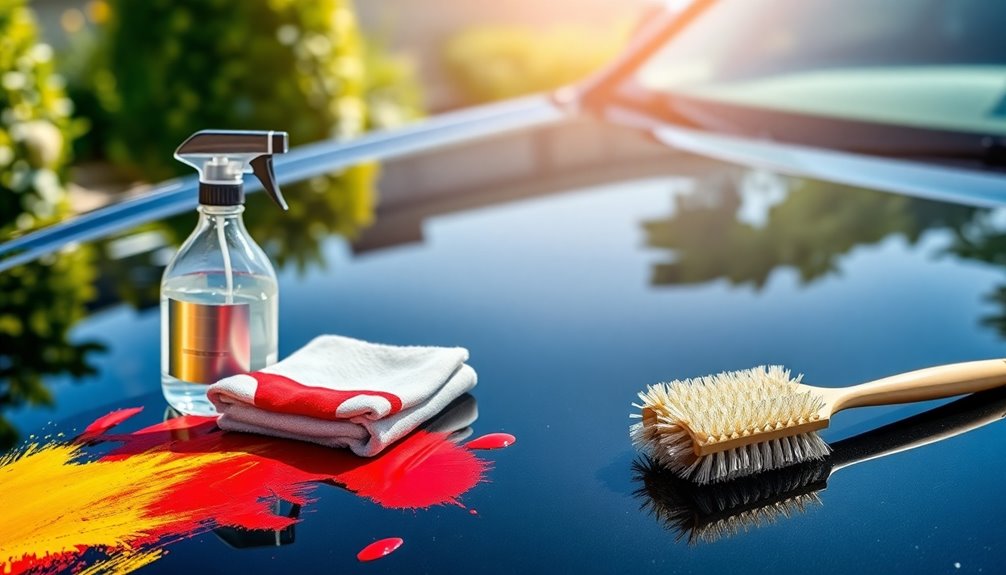
For effectively removing road paint from your car, choosing the right cleaning products is essential. You want something that tackles tough road striping paint while keeping your vehicle's finish intact.
Here are some highly recommended options for overspray removal:
- Motsenbockers LIFT OFF 4: This product is praised for its effectiveness without damaging your paint.
- Stoner XENIT – Intensive Cleaner: Known for dissolving DOT road paint safely, it's a favorite among detailers.
- Goo-Gone: Many users swear by this for stubborn paint, and it's gentle on surfaces.
- Meguiar's Quick Detailer: Use this with plastic razor blades to safely scrape away paint while minimizing scratches.
- Lacquer thinner and acetone: These are harsh yet effective. Just remember to test them on inconspicuous areas first.
Using these products, you can confidently tackle road paint issues.
Just follow the instructions carefully for the best results.
Don't let that unsightly overspray ruin your car's appearance—choose the right cleaning products and restore your vehicle's shine!
Advanced Techniques for Removal
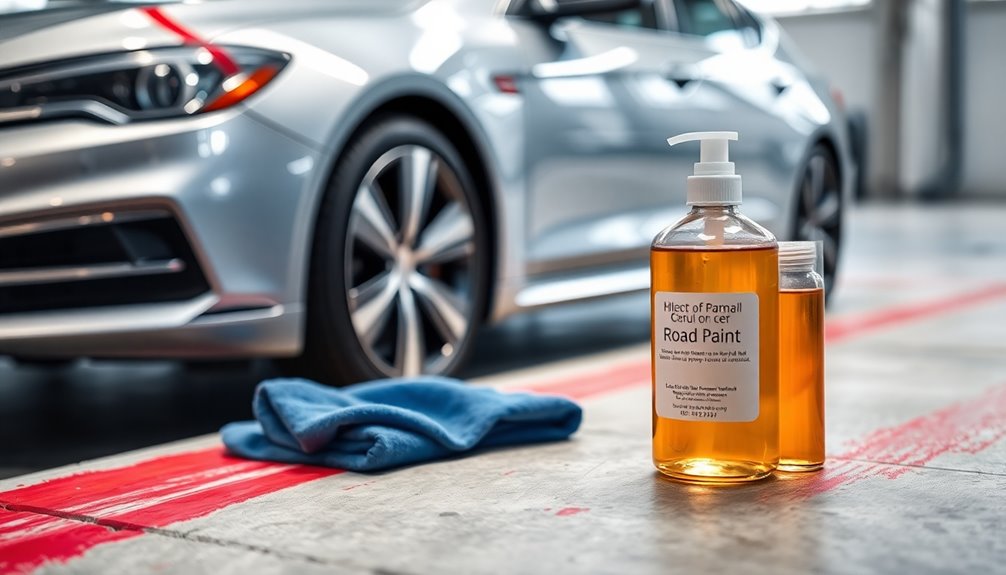
When road paint clings stubbornly to your car, advanced techniques can help you tackle the issue effectively.
You can use heat application methods to soften the paint, while chemical solvents offer powerful options for removal.
Scraping techniques, when done carefully, can also aid in lifting the paint without damaging your vehicle's finish.
Heat Application Methods
Applying heat is an effective method for softening road paint, making it easier to remove without damaging your car's finish. Using a blow dryer or heat gun set to a low temperature, you can carefully heat the affected areas.
Just remember to keep the heat source moving to avoid warping your vehicle's surface.
Here's how to maximize your heat application technique:
- Start by testing on a small, hidden area.
- Allow the heat to penetrate the paint for a few moments.
- Use a plastic razor blade to gently scrape the softened paint.
- Work slowly to guarantee you don't scratch the underlying surface.
- Wipe away any residue as you go for a cleaner finish.
Chemical Solvent Options
After softening the road paint with heat, you might want to explore chemical solvent options for a more thorough removal. Lacquer thinner and acetone are effective chemical solvents, but be sure to test them on an inconspicuous area first. You wouldn't want to damage your vehicle's finish.
For a more specialized solution, consider Motsenbockers LIFT OFF 4, which is specifically designed for removing road paint without harming the underlying paint.
If you're dealing with DOT road paint, Stoner XENIT Natural Citrus Cleaner can be particularly effective. Simply dampen a microfiber towel with it, allowing it to penetrate the paint for best results.
Additionally, using a petroleum-based product like WD-40 can soften the paint, making it easier to scrape off with a plastic razor blade after letting it dwell for 1-2 hours.
For stubborn paint types, MEK (methyl ethyl ketone) and toluene are strong solvents, but handle these with caution. They can damage plastic components and emit harmful fumes, so protective gear is a must.
Always follow safety guidelines and work in a well-ventilated area when using chemical solvents.
Scraping Techniques Explained
To effectively remove road paint from your car, mastering the right scraping techniques is essential. Start by using a plastic razor blade; it minimizes the risk of damaging your vehicle's paint while effectively lifting off the unwanted road paint.
Before you begin scraping, apply heat with a blow dryer or heat gun to soften the paint, making the removal process smoother.
Here are some key points to take into account:
- Always scrape in gentle, steady motions to avoid gouging the surface.
- Work in small sections to maintain control over the scraping process.
- After scraping, use a microfiber cloth dampened with suitable solvent, like mineral spirits, to clean up remaining residue.
- Test your scraping technique and chosen solvent on an inconspicuous area first.
- Patience is key—don't rush the paint removal process.
Safety Precautions to Consider
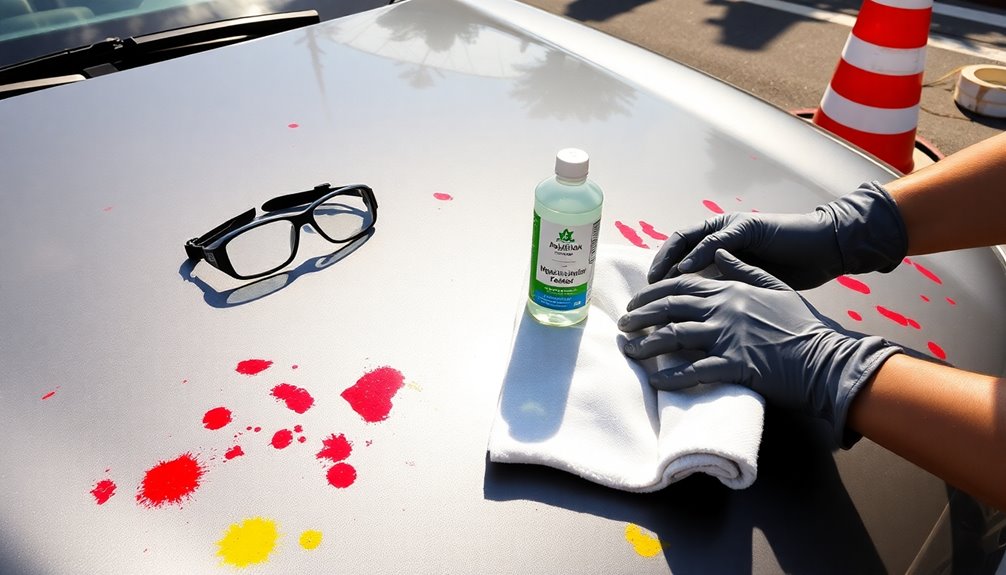
Before you start removing road paint from your car, make sure you're wearing protective gear like gloves and eyewear to shield yourself from harmful chemicals.
It's also essential to work in a well-ventilated area to keep those fumes at bay.
Don't forget to test any cleaning product on a hidden spot first to avoid damaging your car's finish.
Wear Protective Gear
When tackling the task of removing road paint from your car, prioritizing safety is essential.
You'll be working with strong chemicals that can harm your skin and respiratory system, so wearing the right protective gear is vital.
Here's what you need to equip yourself with before starting:
- Gloves: Always wear gloves to prevent skin irritation and protect against harmful substances.
- Safety Goggles: Shield your eyes from potential splashes while applying solvents or scraping paint.
- Mask or Respirator: Avoid inhaling harmful fumes from strong chemicals like lacquer thinner and acetone.
- Long Sleeves: Consider wearing long sleeves and protective clothing to minimize skin contact with paint or cleaning agents.
- Sturdy Footwear: Opt for closed-toe shoes to protect your feet from spills and falling tools.
Ensure Proper Ventilation
Create a safe working environment by ensuring proper ventilation while removing road paint from your car.
When using solvent-based cleaning agents, it's essential to work in a well-ventilated area. These products can emit harmful fumes that may irritate your respiratory system or lead to other health issues. Open windows and doors to create airflow, or use fans to help disperse those fumes as you clean.
If you're stuck in a confined space, consider wearing a respirator or mask designed to filter out volatile organic compounds (VOCs) to protect your lungs.
It's also smart to take breaks often. Step outside to breathe fresh air, which reduces your exposure to any lingering fumes from the cleaning agents.
Always read and follow the safety instructions on product labels. These often include specific recommendations for ventilation and personal protective equipment.
By prioritizing proper ventilation, you're not just protecting yourself; you're ensuring a more effective and safer cleaning process.
Test on Inconspicuous Area
Testing a cleaning agent on an inconspicuous area of your car is an essential step in the road paint removal process. It helps you avoid potential damage to your vehicle's paint.
Begin by selecting a spot like under the hood or inside the trunk. Use a small amount of your chosen cleaner on a clean, soft cloth, and apply it gently to the test area. Observe for any signs of discoloration or damage to the paint finish.
Here's what to keep in mind during your test:
- Protect your car's finish from unwanted reactions.
- Ensure the cleaner doesn't harm the original paint.
- Allow the cleaner to sit for the recommended dwell time.
- Monitor the area for 24 hours for any delayed reactions.
- Remain cautious when proceeding to the affected areas.
If the test area shows no adverse effects, you can proceed with the cleaner on the road paint.
Just remember to apply it carefully, ensuring you keep your car's paint in pristine condition. Trust your instincts; a careful test can save you from costly mistakes.
Community Tips and Experiences
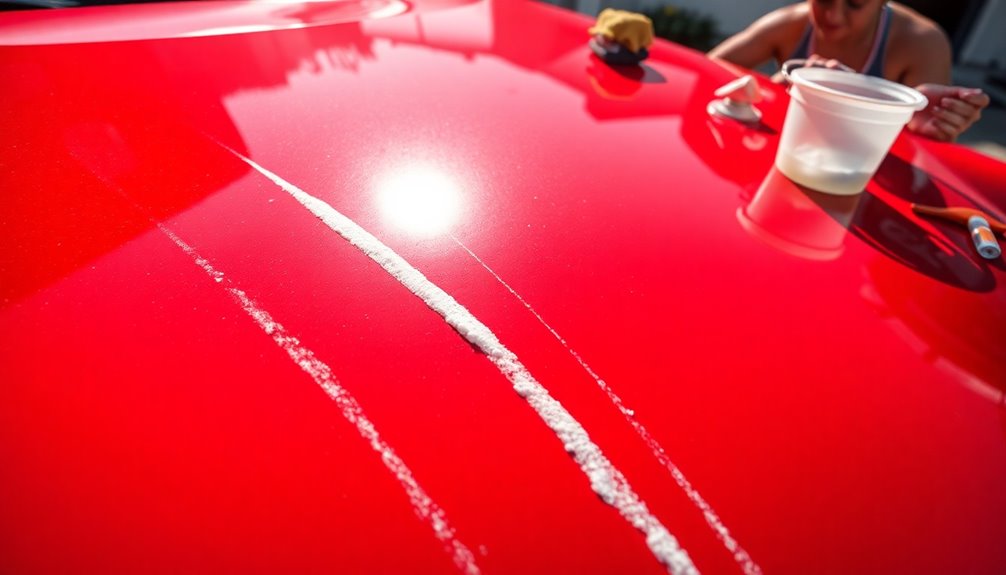
Community members have shared a wealth of tips and experiences for effectively removing road paint from cars. Many recommend using Motsenbockers LIFT OFF 4, which can remove road painting without harming your vehicle's surface. Additionally, using essential oils can help maintain the car's finish while removing paint.
If you prefer a different approach, try Stoner XENIT Citrus Cleaner with a damp microfiber towel. Users suggest letting it penetrate the paint for a bit before wiping it away.
For stubborn paint, personal experiences highlight the effectiveness of acetone paired with plastic razor blades. Soak the area briefly before carefully scraping off the paint. This method has proven successful for many in the community.
It's essential to conduct a test on an inconspicuous area first, as some chemicals can damage your car's finish. Participants in online forums often stress this point.
Additionally, combining pressure washing with repeated applications of targeted paint removers can yield excellent results. Furthermore, using a high suction power vacuum can help clean up any debris left behind during the paint removal process.
Professional Services Available
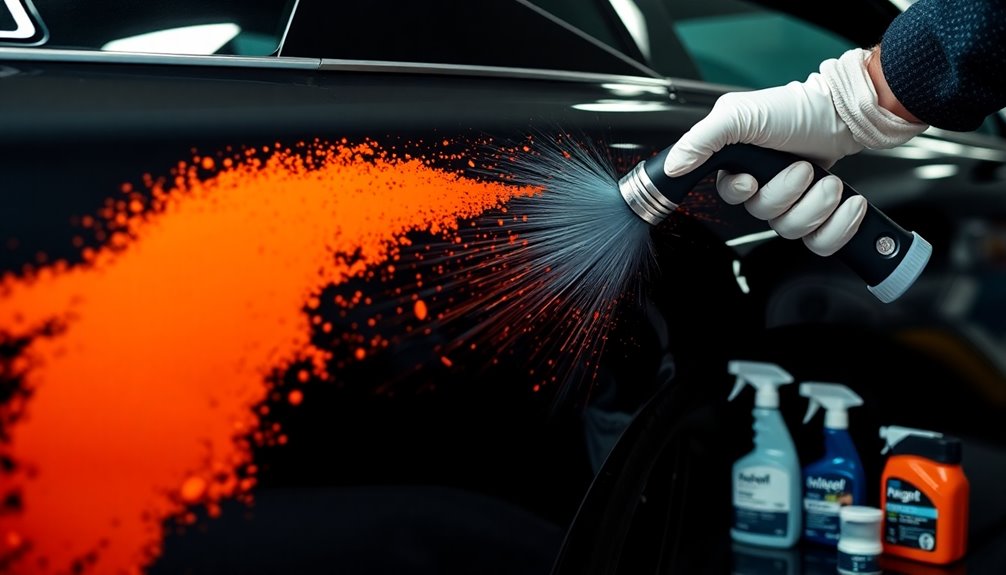
If DIY methods haven't quite worked for you, consider reaching out to professional services for road paint removal. Companies like Overspray Removal Specialists, Inc. specialize in this exact issue and can provide the expertise you need. You can contact them at 800-835-5858 or visit their website at www.overspray.com for more information.
Hiring professional services offers several advantages, including:
- Advanced techniques: They use methods and products not available to the general public.
- Expertise: Trained professionals understand how to tackle stubborn paint effectively.
- Minimized risk: Engaging experts reduces the chance of damaging your vehicle's paint finish.
- Positive outcomes: Many users rave about their successful experiences with professionals.
- Time-saving: Let the experts handle it while you focus on other tasks.
Professional paint removal services can guarantee that your car looks its best without the stress of trying to remove road paint yourself.
When faced with stubborn or extensive paint issues, expert help can make all the difference in restoring your vehicle's appearance.
Environmental Impact Awareness

When you're dealing with road paint removal, it's essential to evaluate the environmental impact of your methods.
Opting for eco-friendly paint alternatives and safe removal techniques can greatly reduce harm to nature.
Eco-friendly Paint Alternatives
As awareness of environmental issues grows, it's essential to reflect on eco-friendly paint alternatives for road striping.
The Department of Transportation (DOT) is making strides by utilizing environmentally friendly waterborne paints that greatly reduce harmful volatile organic compounds (VOCs) compared to traditional solvent-based options.
These paints not only improve air quality but also minimize soil and water contamination during application.
Consider the benefits of these eco-friendly alternatives:
- Improved air quality during paint application
- Biodegradable options that lessen long-term environmental impact
- Lower emissions leading to a healthier community
- Durability through advanced materials like methyl-methacrylate
- Less pollution from responsible removal methods
Additionally, the use of energy-efficient technology in paint applications can contribute to sustainability goals in road maintenance.
Safe Removal Methods
Removing road paint from your car requires careful consideration of both effective techniques and environmental impact. To guarantee a responsible approach, you should always opt for safe removal methods that utilize environmentally friendly products. Waterborne paint removers are a great choice, as they minimize chemical effects on the environment.
When it comes to techniques, avoid using harsh solvents that can release volatile organic compounds (VOCs) into the air. Instead, consider methods like pressure washing or using plastic razor blades. These options effectively remove paint without damaging your vehicle's finish or harming the surrounding environment.
It's also important to be cautious with disposal practices. Properly dispose of any cleaning materials or paint residue to prevent contamination of soil and waterways.
If you're uncertain about tackling the task yourself, consider hiring professional paint removal services that prioritize eco-friendly practices. They can guarantee effective removal while keeping environmental concerns front and center.
Minimizing Environmental Harm
Minimizing environmental harm during road paint removal is vital for protecting local ecosystems. By choosing environmentally conscious methods, you can guarantee that your efforts to remove road paint don't inadvertently harm the environment.
Many traditional paint removal techniques release volatile organic compounds (VOCs) that contribute to air pollution, so it's important to opt for safer alternatives.
Consider these eco-friendly practices:
- Use biodegradable paint removers that break down naturally.
- Follow local regulations for the disposal of hazardous materials to avoid contamination.
- Minimize chemical runoff by working in a controlled environment, like a garage.
- Choose waterborne paint products for future projects, as they're less harmful.
- Spread awareness about the importance of eco-friendly methods in your community.
Maintaining Your Vehicle's Finish
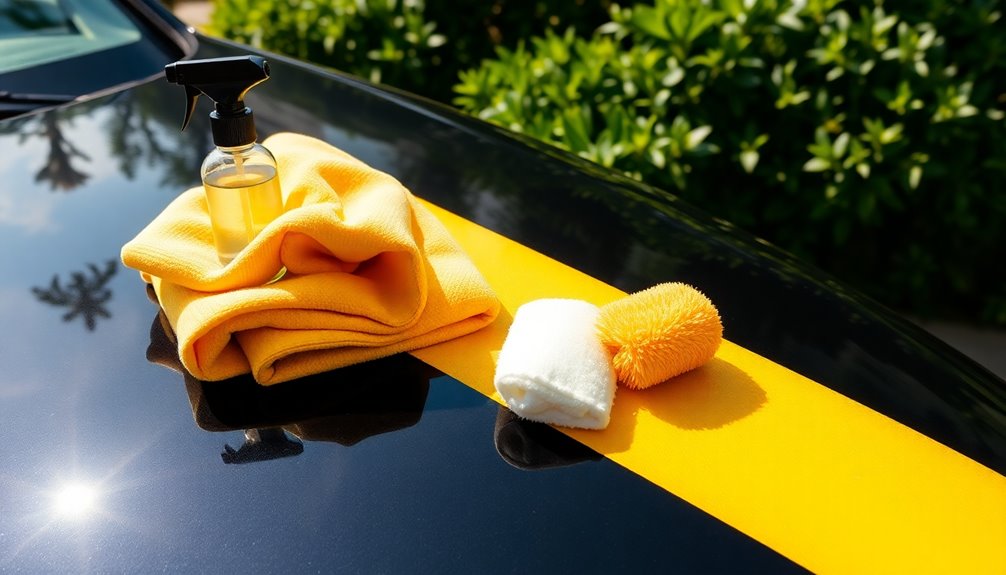
Maintaining your vehicle's finish is essential for preserving its appearance and value. Regularly applying a high-quality wax or sealant protects your paint from contaminants like road paint and enhances its longevity and shine. This simple step creates a barrier that makes it harder for harmful substances to adhere to your car's surface.
Washing your vehicle frequently, especially after roadwork, can help prevent road paint from sticking too strongly. Aim to use a pH-balanced car shampoo during washes; this keeps your clear coat intact and maintains the integrity of your paint finish over time.
When drying your vehicle or applying cleaning products, always opt for microfiber towels. They minimize the risk of scratching your paint, ensuring a smooth surface.
Additionally, consider parking in covered areas or using vehicle covers whenever possible. This shields your car from exposure to road paint during maintenance activities, further reducing the chances of paint transfer.
Long-Term Care and Prevention
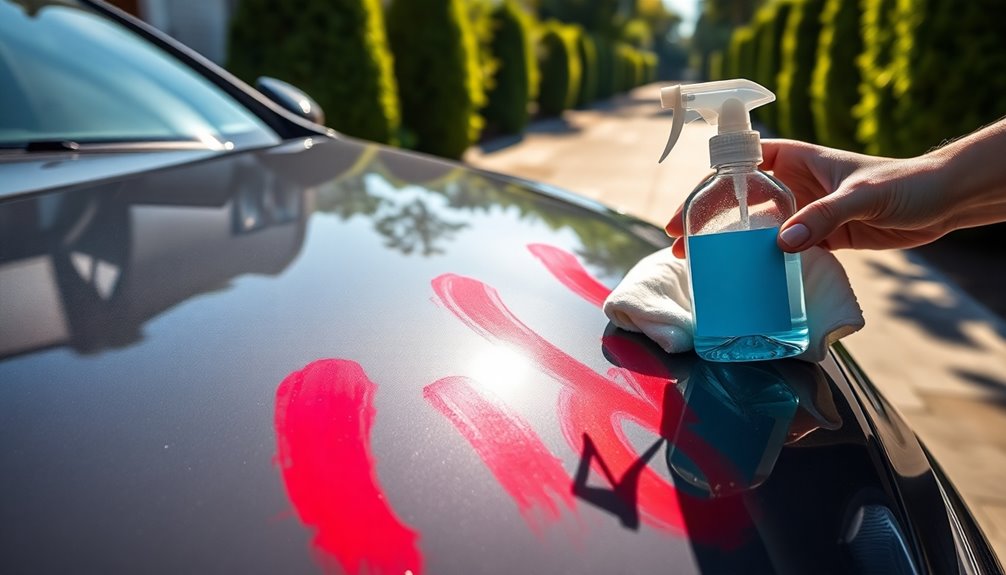
Taking proactive steps can greatly reduce the risk of road paint damaging your vehicle. By implementing some simple strategies, you can protect your car and maintain its pristine appearance.
Here's how to create a solid plan for preventing road paint:
- Regularly wash your vehicle, especially after road painting operations.
- Apply a quality wax or sealant to create a protective barrier.
- Park away from freshly painted roads or roadwork areas.
- Use paint protection film on vulnerable areas like fender wells and bumpers.
- Check local DOT schedules to plan your routes effectively.
These actions not only help in preventing road paint but also maintain your car's overall finish.
Regular washes will prevent paint buildup while a waxed surface makes it harder for contaminants to stick. Staying informed about roadwork can keep you out of trouble, and protective films give you that extra layer of defense.
Frequently Asked Questions
How Do I Get Dried Road Paint off My Car?
To tackle dried road paint, start by applying petroleum jelly to the affected area, letting it sit for 8-12 hours to soften the paint.
Once it's softened, gently scrape it off using a plastic razor blade, being careful not to damage your car's surface.
After scraping, use a pressure washer to remove any remaining residue.
If needed, finish off with rubbing alcohol to eliminate leftover traces.
Always test any chemicals on a hidden spot first!
Does WD-40 Remove Car Paint?
Did you know that over 70% of car owners have faced some type of paint damage?
WD-40 can be a helpful solution for removing unwanted paint from your car. It works best when applied promptly and allowed to sit for 1-2 hours.
Just spray it on the affected area, then gently wipe it off with a microfiber cloth. Always test it on a small, hidden spot first to verify it won't harm your car's finish.
What Chemical Removes Road Marking Paint?
When it comes to removing road marking paint, several chemicals can help. You might want to try Motsenbockers LIFT OFF 4, as it's specifically designed for this purpose.
Stoner XENIT is another safe option, using natural citrus ingredients. If you're feeling bold, lacquer thinner or acetone can work, but always test them first.
Goof Off is effective too, but it might strip protective coatings, so be cautious during application.
Will a Car Wash Take off Road Paint?
A car wash mightn't effectively remove road paint, especially if it's dried and stuck to your vehicle.
While pressure washing can help with fresh paint, most car washes focus on cleaning dirt and grime rather than specialized paint removal.
If the paint's stubborn, you may need to look into professional services or specific DIY methods to tackle the issue.
Don't rely solely on a car wash for this type of problem.
Conclusion
So, you've tackled that pesky road paint on your car and maybe even discovered a few handy tips along the way. Isn't it funny how something as simple as a drive can lead to unexpected challenges? By following these steps, you're not just cleaning your vehicle; you're preserving its beauty and value. Remember, staying proactive can save you time and hassle in the future. Keep your car shining bright, and you'll always be ready for that next adventure!
